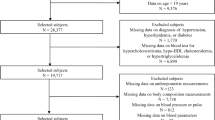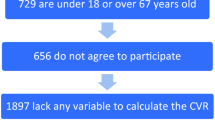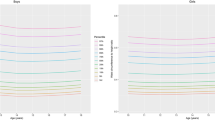Abstract
OBJECTIVE: The normal body mass index (BMI) range, as defined by the World Health Organization (WHO), is quite wide, and some people within this range may have excessive central fat accumulation and elevated metabolic risks. We hypothesize that the waist-to-height ratio (W/Ht), an effective index for assessing central fat distribution among Japanese people, can be used to identify subjects who are at higher metabolic risk within the normal as well as the overweight range.
METHODS: We investigated: (1) the values of BMI, waist circumference, and W/Ht in 6141 men and 2137 women at various age intervals and calculated gender (female to male) ratios for all these anthropometric indices; (2) the relation between age and each anthropometric index, between age and morbidity index for coronary risk factors (sum of the scores for hyperglycemia, hypertension, hypertriglyceridemia, hypercholesterolemia, and low HDL cholesterol; one point for each condition if present), and between morbidity index for coronary risk factors and each anthropometric index; (3) the distributions of the subjects, using various proposed indices of waist circumference (those suggested by WHO, the Japan Society for the Study of Obesity, and the Asia-Pacific perspective), and our proposed boundary value, W/Ht 0.5, among the WHO categories based on BMI; (4) the metabolic risks (coronary risk factors, hyperuricemia, high γ-glutamyltransferase, and fatty liver diagnosed by ultrasonography), and exercise habits among normal-weight subjects with W/Ht<0.5 or ≥0.5.
RESULTS: (1) For the various anthropometric indices in all age groups, the gender ratio for W/Ht was closest to 1, indicating that a single set of values for W/Ht can be used for men and women. (2) Height correlated negatively with age. Among the anthropometric indices, only W/Ht correlated positively with age for both men and women, while age and all anthropometric indices, except height, correlated positively with the morbidity index for coronary risk factors. For both men and women, the highest correlation coefficient was between W/Ht and the morbidity index for coronary risk factors. (3) Nearly all overweight men and women (BMI≥25) had W/Ht≥0.5 (98.5% of men and 97.5% of women). None of the underweight subjects had W/Ht≥0.5. However, 45.5% of men and 28.3% of women of normal weight (BMI 18.5–<25) had W/Ht≥0.5. W/Ht, of all the indices investigated, was the best index for signaling metabolic risk in the normal-weight subjects as well as the overweight subjects. (4) Age- and BMI-adjusted odds ratios for multiple metabolic risks, and history of no habitual exercise were significantly higher in normal-weight men and women with W/Ht≥0.5 than in others of normal weight.
CONCLUSIONS: Waist circumference is improved by relating it to height to categorized fat distribution of different genders and ages. W/Ht is a simple and practical anthropometric index to identify higher metabolic risks in normal and overweight Japanese men and women.
This is a preview of subscription content, access via your institution
Access options
Subscribe to this journal
Receive 12 print issues and online access
$259.00 per year
only $21.58 per issue
Buy this article
- Purchase on Springer Link
- Instant access to full article PDF
Prices may be subject to local taxes which are calculated during checkout

Similar content being viewed by others
References
WHO. The problem of overweight and obesity. Obesity: preventing and managing the global epidemic. Report of a WHO Consultation. WHO Technical Report Series, Series 894, 2000; p 5–37.WHO publication.
Yoshiike Y, Matsumura M, Zaman MM, Yamaguchi M . Descriptive epidemiology of body mass index in Japanese adults in a representative sample from the National Nutrition Survey 1990–1994. Int J Obes Relat Metab Disord 1998; 22: 684–687.
de Onis M, Habicht JP . Anthropometric reference data for international use: recommendations from a World Health Organization Expert Committee. Am J Clin Nutr 1996; 64: 650–658.
Smalley KJ, Knerr AN, Kendrick ZV, Colliver JA, Owen OE . Reassessment of body mass indices. Am J Clin Nutr 1990; 52: 405–408.
Blair D, Habicht JP, Sims EA, Sylwester D, Abraham S . Evidence for an increased risk for hypertension with centrally located body fat and the effect of race and sex on this risk. Am J Epidemiol 1984; 119: 526–539.
Kaplan NM . The deadly quartet. Upper-body obesity, glucose intolerance, hypertriglyceridemia, and hypertension. Arch Intern Med 1989; 149: 1514–1520.
Deprés JP . Lipoprotein metabolism in visceral obesity. Int J Obes Relat Metab Disord 1991; 15: S45–S52.
Hsieh SD, Yoshinaga H . Is there any difference in coronary heart disease risk factors and prevalence of fatty liver in subjects with normal body mass index having different physiques? Tohoku J Exp Med 1995; 177: 223–231.
Ruderman N, Chisholm D, Pi-Sunyer X, Schneider S . Perspective in diabetes. The metabolically obese, normal-weight individual revisited. Diabetes 1998; 47: 699–713.
Hsieh SD, Yoshinaga H, Muto T, Sakurai Y, Kosaka K . Health risks among Japanese men with moderate body mass index. Int J Obes Relat Metab Disord 2000; 24: 358–362.
Japan Society for the Study of Obesity. New criteria for the diagnosis of obesity. Himankenkyu 2000; 6: 18–28 [in Japanese].
Steering Committee. Assessment diagnosis. The Asia-Pacific perspective: redefining obesity and its treatment, 2000; p 15–21. Health Communications Australia Pty Limited publication.
Hsieh SD, Yoshinaga H . Abdominal fat distribution and coronary heart disease risk factors in men—waist/height ratio as a simple and useful predictor. Int J Obes Relat Metab Disord 1995; 19: 585–589.
Hsieh SD, Yoshinaga H . Waist/height ratio as a simple and useful predictor of coronary heart disease risk factors in women. Intern Med 1995; 34: 1147–1152.
Lee JS, Aoki K, Kawakubo K, Gunji A . A study on indices of body fat distribution for screening for obesity. J Occup Health 1995; 37: 9–18.
Hsieh SD, Yoshinaga H . The relationships between various obesity indices and coronary heart risk factors. The comparisons of waist/height ratio to other obesity indices. J Jpn Human Dry Dock 1996; 11: 130–133 [in Japanese].
Hsia HH, Huang KC, Lin WC, Shau WY, Lin RS . Optimal cut-off values for obesity using simple anthropometric indexes to predict cardiovascular risk factors in Taiwan (First Asia-Oceania Conference on Obesity). Himankenkyu 2001; 7: S79.
Larsson B, Svärdsudd K, Welin L, Wilhelmsen L, Björntorp P, Tibblin G . Abdominal adipose tissue distribution, obesity, and risk of cardiovascular disease and death: 13 year follow up of participants in the study of men born in 1913. BMJ 1984; 288: 1401–1404.
Osono Y, Nakajima K, Hata Y . Hypertriglyceridemia and fatty liver: clinical diagnosis of fatty liver and lipoprotein profiles in hypertriglyceridemic patients with fatty liver. J Atheroscler Thromb 1995; 2: S47–S52.
Vague J . The degree of masculine and differentiation of obesities—a factor determining predisposition to diabetes, atherosclerosis, gout, and uric calculous disease. Am J Clin Nutr 1956; 4: 20–34.
Lapidus L, Bengtsson C, Larsson B, Pennert K, Rybo E, Sjöström L . Distribution of adipose tissue and risk of cardiovascular disease and death: a 12 year follow up of participants in the population study of women in Gothenburg, Sweden. BMJ 1984; 289: 1257–1261.
Croft JB, Keenan NL, Sheridan DP, Wheeler FC, Speers MA . Waist-to-hip ratio in a biracial population: measurement, implications, and cautions for using guidelines to define high risk for cardiovascular disease. J Am Diet Assoc 1995; 95: 60–64.
Little P, Byrne CD . Abdominal obesity and the “hypertriglyceridaemic waist” phenotype. It's probably not yet time to implement screening. BMJ 2001; 322: 687–689.
Molarius A, Seidell JC, Sans S, Tuomilehto J, Kuulasmaa K . Varying sensitivity of waist action levels to identify subjects with overweight or obesity in 19 populations of the WHO MONICA Project. J Clin Epidemiol 1999; 52: 1213–1224.
Hsieh SD, Yoshinaga H, Muto T, Sakurai Y . Anthropometric obesity indices in relation to age and gender in Japanese adults. Tohoku J Exp Med 2000; 191: 79–84.
Forbes GB, Reina JC . Adult lean body mass declines with age: some longitudinal observations. Metabolism 1970; 19: 653–663.
Cohn SH, Vartsky D, Yasumura S, Sawitsky A, Zanzi I, Vaswani A, Ellis KJ . Compartmental body composition based on total-body nitrogen, potassium, and calcium. Am J Physiol 1980; 239; E524–E530.
Borkan GA, Hults DE, Gerzof SG, Robbins AH, Silbert CK . Age changes in body composition revealed by computed tomography. J Gerontol 1983; 38: 673–677.
Hsieh SD, Yoshinaga H . Do people with similar waist circumference share similar health risks irrespective of height? Tohoku J Exp Med 1999; 188: 55–60.
Hebert PR, Rich-Edwards JW, Manson JE, Ridker PM, Cook NR, O'Connor GT, Buring JE, Hennekens CH . Height and incidence of cardiovascular disease in male physicians. Circulation 1993; 88: 1437–1443.
Parker DR, Lapane KL, Lasater TM, Carleton RA . Short stature and cardiovascular disease among men and women from two southeastern New England communities. Int J Epidemiol 1998; 27: 970–975.
Hsieh SD, Yoshinaga H, Muto T, Sakurai Y . Regular physical activity and coronary risk factors in Japanese men. Circulation 1998; 97: 661–665.
Fentem PH, Mockett SJ . Physical activity and body composition: what do the national surveys reveal? Int J Obes Relat Metab Disord 1998; 22: S8–S14.
Kristenson H, Trell E, Fex G, Hood B . Serum γ-glutamyltransferase: statistical distribution in a middle-aged male population and evaluation of alcohol habits in individuals with elevated levels. Prev Med 1980; 9: 108–119.
Ashwell M, Lejeune S, McPherson K . Ratio of waist circumference to height may be better indicator of need for weight management. BMJ 1996; 312: 377.
Cox BD, Whichelow MJ, Ashwell M, Prevost AT, Lejeune SRE . Association of anthropometric indices with elevated blood pressure in British adults. Int J Obes Relat Metab Disord 1997; 21: 674–680.
Ashwell M . The Ashwell shape chart—a public health approach to the metabolic risks of obesity. Int J Obes Relat Metab Disord 1997; 22: S213.
Savva SC, Tornaritis M, Savva ME, Kourides Y, Panagi A, Silikiotou N, Georgiou C, Kafatos A . Waist circumference and waist-to-height ratio are better predictors of cardiovascular disease risk factors in children than body mass index. Int J Obes Relat Metab Disord 2000; 24: 1453–1458.
Hara M, Saito E, Yoshino Y, Iwata F, Okada T, Harada K . The usefulness of waist-to-height ratio as a simple index for the prediction of arteriosclerotic risk factors in school children. Himankenkyu 2001; 7: 253–260 [in Japanese].
Acknowledgements
We thank Mitsui Chemical Industries, Ltd for providing financial support for this study.
Author information
Authors and Affiliations
Corresponding author
Rights and permissions
About this article
Cite this article
Hsieh, S., Yoshinaga, H. & Muto, T. Waist-to-height ratio, a simple and practical index for assessing central fat distribution and metabolic risk in Japanese men and women. Int J Obes 27, 610–616 (2003). https://doi.org/10.1038/sj.ijo.0802259
Received:
Revised:
Accepted:
Published:
Issue Date:
DOI: https://doi.org/10.1038/sj.ijo.0802259
Keywords
This article is cited by
-
Waist-to-height ratio associated cardiometabolic risk phenotype in children with overweight/obesity
BMC Public Health (2023)
-
Predicting anthropometric and metabolic traits with a genetic risk score for obesity in a sample of Pakistanis
Scientific Reports (2021)
-
Usefulness of waist-to-height ratio in screening incident hypertension among Japanese community-dwelling middle-aged and elderly individuals
Clinical Hypertension (2020)
-
Cross-sectional study of associations between normal body weight with central obesity and hyperuricemia in Japan
BMC Endocrine Disorders (2020)
-
High birth weight and its interaction with physical activity influence the risk of obesity in early school-aged children
World Journal of Pediatrics (2020)



